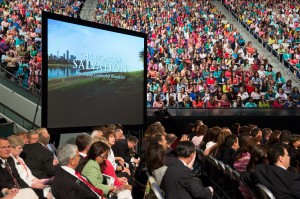The announcement that missionaries from The Church of Jesus Christ of Latter-day Saints would use social media and give church tours as proselyting tools was a surprise to most, but to a handful of returned missionaries, the announcement was long overdue.
On June 23, the Church held a worldwide missionary training broadcast announcing the exciting changes. Elder L. Tom Perry of the Quorum of the Twelve Apostles summed up the purpose when he said, “the Church must adapt to a changing world.”

Several missions began testing the new proselyting features years before the announcement last week, and several returned missionaries were eager to share their experiences.
BYU students Shane Wood and Matt Lee served in the Montana Billings Mission from 2010 to 2012. Shortly after they arrived in the field, leadership began to implement proselyting by means of social media.
“It was very casual, which is what I really liked about it, so we got a great response from the average nonmember,” Wood said.
According to Lee, missionaries were not required to use social media as a proselyting tool, but rather, their mission president gave the missionaries an option to use it.
“There were a few that chose not to use the Internet for a while and then they saw the benefits of it and saw what it was used for,” Lee said. “Then they felt comfortable enough. I don’t know of anyone that never used it.”
Before missionaries were allowed to dive into social media, they were interviewed by the mission president. Strict adherence to the rules resulted in the ability to use social media, at which time missionaries were instructed to create new Facebook profiles and not to use their old personal profiles. Only an hour of social media use was permitted per day, and missionaries were encouraged to use it during the mornings when tracting was less effective.
Social media use became so successful that it even changed the organization of the mission.
“As we became smarter with it the mission president called two online assistants,” Lee said. “They were in charge of presentations, trainings for how to work online effectively as well as policing.”
Wood and Lee said online safety became a concern for missionaries, creating new challenges.
“In the beginning we had a lot of people adding us that were just kind of suspicious, out-of-the-country people like foreign girls,” Wood said. “This one lady from like Brazil wanted to bake my companion a cake … we did not accept that offer.”
“We were encouraged to only add people we knew,” Lee added. “My Facebook was in the process of being hacked twice. Luckily I stopped it before anything bad happened.”
Kara Leigh Grenfell, a BYU student who teaches at the Missionary Training Center, served in the Washington Tacoma Mission from 2011 to 2013 and entered the mission field after church tours had become an integral part of her mission.
“Baptisms were the goal, and a means to that end was church tours,” Grenfell said. “That’s how important it was in the beginning of my mission.”
BYU student Chris Larsen also served in the Washington Seattle mission, where missionaries piloted church tours. He said several investigators benefited from seeing the chapel beforehand.
“Probably the one big benefit is that you’re playing on your home turf,” Larsen said. “You’re in a dedicated building that is already a place where the Spirit is present.”
Grenfell said missionaries were still required to do traditional tracting but that many missionaries found church tours extremely helpful and rewarding.
“You always wanted people to come to the church. … We did church tours throughout all times of the day,” Grenfell said. “Families, teenagers … we did it with anyone that wanted to have one.”
Even with the benefit of church tours, there were still difficulties.
“Sometimes investigators can feel out of their element and be a bit uncomfortable,” Larsen said. “So if you’re teaching them and they’re uncomfortable it’s like throwing spit wads at a brick wall; it won’t stick very well.”
Even though concerns about the new proselyting techniques exist, the missionaries who experienced the pilot programs agree that the pros outweigh the cons. With social media and church tours, the Church is adapting to the changing times in order to remain effective and spread the gospel.




